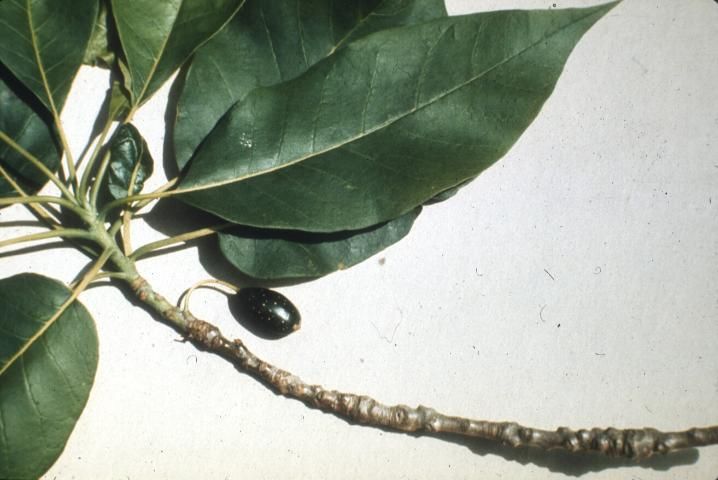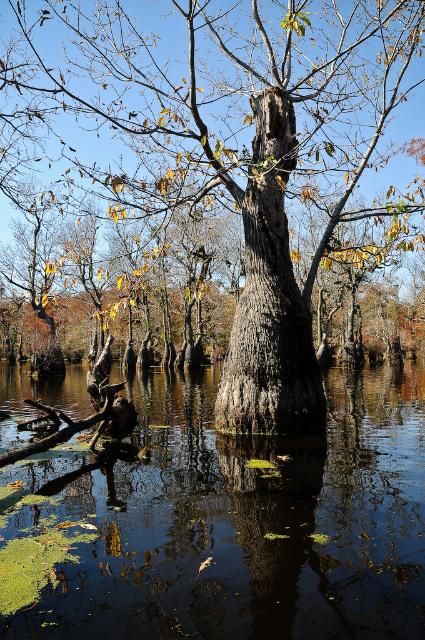Family
Cornaceae, dogwood family.
Genus
Nyssa was the name of an ancient Greek mythological water goddess.
Species
The species name, aquatica, stems from Latin and means "of water."
Common Name
Water Tupelo, Cotton Gum
The word "tupelo" is said to have stemmed from the language of the Creek tribe and means "swamp tree." The other common name, "cotton gum," is thought to come from the cottony feeling one gets in one's mouth after eating the bitter fruits.
Description
This native deciduous tree is found in the bottomlands, floodplains, and swamps of southern Virginia, south to northwest Florida, west to southeastern Texas, and north through the Mississippi River Valley. Mature trees grow best in full sunlight and can reach heights of approximately 100 feet. Leaves are simple and alternate and grow from 5 to 8 inches long. They are ovate (egg shaped) and have entire or smooth margins that sometimes have serrations (teeth). The thick leaves are shiny dark green on the topside and paler and pubescent on the underside. The trunk is buttressed at the base and its bark is dark brown or dark gray and splits into finely scaled ridges. In the spring, green flowers appear in clusters on long stalks. Male and female flowers appear on separate trees. The male flowers are about ¼ inch long and appear in clusters, while the female flowers are about ¾ inch long and are solitary. Oblong shaped drupes (fleshy fruits that usually contain one seed) about ½ inch to 1½ inches long ripen in early fall and are dark blue to dark purple.

Credit: SJQuinney, CC BY-NC-SA 2.0

Credit: bumeister1, CC BY 2.0
Allergen
The male tupelo is extremely allergenic and the female tree causes few to no allergies.
Storm Tolerance
This tree has a medium to high wind tolerance.
Applications
Commercial/Practical
Tupelos are well known for their smooth, sweet-tasting honey, produced by bees that have been drawn to the sweet nectar of their small flowers. The wood has a fine texture and is often used to make baskets, boxes, pallets, and furniture. The swollen buttress of the tree weighs less than the wood of the bole and is commonly used for making duck decoys because it is both buoyant and easily carved. Additionally, a cork substitute has been made from the spongy material of the roots and has been used to float fish nets.
Horticultural
Water tupelo is a great tree to plant on the edge of a lake or pond in backyards or parks.
Wildlife
Many bird species, especially waterfowl and small mammals, use the fruit as a food source, and deer browse on new foliage and twigs.
References
Austin, D. F. 2004. Florida ethnobotany. Boca Raton, FL: CRC Press.
Borror, D. J. 1988. Dictionary of root words and combining forms. Mountain View, CA: Mayfield Publishing Company.
Burns, R. M., Honkala, B. H., & coordinators. 1990. Silvics of North America: Volume 2. hardwoods (Vol. 2). Washington, D.C.: U.S. Government Printing Office.
Duryea, M. and E. Kampf. 2007. Selecting Southeastern Coastal Plain tree species for wind resistance (FOR118). Gainesville, FL: UF-IFAS Florida Cooperative Extension Service. Retrieved from https://edis.ifas.ufl.edu/fr174
Godfrey, R. K. 1988. Trees, shrubs, and woody vines of Northern Florida and adjacent Georgia and Alabama. Athens, GA: The University of Georgia Press.
Haehle, R. J. and J. Brookwell. 2004. Native Florida plants: Low-maintenance landscaping and gardening. Lanham, MD: Taylor Trade Publishing.
Little, E. L. 2005. National Audubon Society field guide to trees, Eastern region. New York, NY: Alfred A. Knopf, Inc.
Nelson, G. 1994. The trees of Florida: A reference and field guide. Sarasota, FL: Pineapple Press.
Peattie, D. C. 1977. A natural history of trees of eastern and central North America. Boston, MA: Houghton Mifflin Company.
Ogren, T. L. 2000. Allergy-free gardening: The revolutionary guide to healthy landscaping. Berkeley, CA: Ten Speed Press.